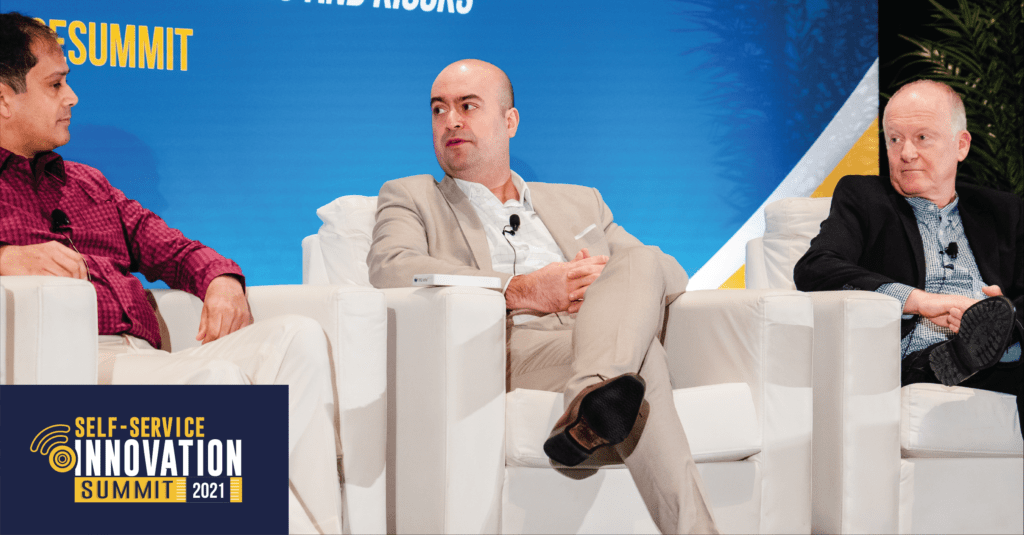Glenn ImObersteg, Holo Industries, presents Raza Shah of Jabil, Nima Ziraknejad of NZ Technologies Inc. and Anthony Uhrick of Neonode. Bruno Capreau of Mastercard and Kazuhiro Yamamoto of Asukanet Co. joined remotely.
Touchless solutions have gained acceptance during the pandemic, but more customer education is needed as the technology continues to evolve beyond hygiene benefits.
Touch-free interaction made significant strides during the coronavirus pandemic in response to customer safety concerns. But have consumers embraced these solutions and will they continue to use them post pandemic?
A panel of technology providers organized to address this question at last month’s Self-Service Innovation Summit in Hollywood, Florida felt consumer acceptance has been positive for touchless solutions, but more customer education is needed as the technology continues to evolve beyond hygiene benefits.
The session, moderated by Glenn ImObersteg, CEO of Holo Industries, a company that merges test sensor modules and holographic plates, was titled, “Germ-Free, Contactless and Beyond.”
The panelists agreed the pandemic raised consumer acceptance of touchless solutions.
Nima Ziraknejad of NZ Technologies Inc. responds to a question, flanked at left by Raza Shah of Jabil and Anthony Uhrick of Neonode
Panelist Bruno Carpeau, director of product management at Mastercard who joined the panel remotely, said attention to hygiene is here to stay and has changed the payments industry beyond security and convenience
Panelist Raza Shah, technology strategy and design leader, Jabil, a designer of applications using contactless technologies, said the technologies emerging in response to the pandemic will continue post-pandemic for people who will want to continue to use contactless.
Some people will, however, revert to more traditional habits, Shah said.
Customer education needed
Panelist Anthony Uhrick, North America sales manager at Neonode Inc., a manufacturer of touch sensor modules, said consumer acceptance of touchless will increase over time as long as deployers continue to educate them. He said there is a lag in consumer adoption since most people are not yet aware of the technology.
“The biggest challenge is customer understanding,” said Uhrick. “While the technology will work, it’s getting a customer to understand that they don’t in fact touch the screen or how to interact with it.”
Neonode’s optical technology allows tracking the position of a stylus or a finger in the air to work with holographic displays. The technology reads a reflection or a blockage of light and sends an XY coordinate to the operating system. The solution has been used in e-readers and in automobile console stacks to interact with displays, and in HP laser printers and Lexmark printers.
Uhrick said beyond the pandemic, the benefits are not restricted to contactless touch.
“On the holographic side, it doesn’t just have to be a hygiene solution…it’s digital signage, a different way to attract attention,” he said. “And there are very few touch technologies that allow you to interact in space with an image.”
One locker company was looking for a way to verify someone had pulled something out of a locker, for example.
“That’s something we could do; we could do it inexpensively,” he said.
User experience critical
“People need to be intuitively familiar with the technology,” agreed panelist Kazuhiro Yamamoto, chief global strategist at Asukanet Co. Ltd., a company that makes holographic applications that has deployed its technology at the Bank of Hiroshima in response to COVID. To date, Yamamoto, who joined the panel remotely, said customer feedback has been positive.
Asukanet’s holographic plates can turn any image or video into a holograph without using glasses or head gear.
Nima Ziraknejad, founder and CEO, NZ Technologies Inc., which manufactures AI powered sensor technology to provide a touchless experience, agreed that touchless solutions must be intuitive to win customer acceptance.
NZ Technologies developed its “HoverTap” solution inspired by its Tipso line of products that allow surgeons to examine images from different vantage points. The first application of “HoverTap” technology is in elevators, he said, and is now being used to reduce “high touch” surfaces. The company’s goal is to bring HoverTap into further applications including kiosks, ATMs, fuel pumps and more.
“Technology is not really the most difficult thing to achieve in the medical field,” Ziraknejad said. “It is that satisfaction that you need to bring to your end users, who are the surgeons…they need to be dealing with a shallow learning curve…it has to be intuitive, it has to be easy to use quick.”
Glenn ImObersteg of Holo Industries cites benefits of touchless technology beyond hygiene as Raza Shah of Jabil looks on.
Voice technology to evolve
Future contactless technologies will include voice technology, the panelists agreed.
ImObersteg observed that a lot of exhibitors at the Summit were showing ADA compliant voice technology.
“Voice has traditionally been seen as something in the home,” Shah of Jabil said. “You move it outside of the home into more of an industrial or medical sector, it has its own challenges because a lot of a lot of noise in the background.”
One challenges with voice, Shah said, is that a high level of reliability is needed in environments outside the home. Another concern is that there is always a microphone recording the sound, meaning the data is being recorded for some party, making protection of privacy a concern.
Voice systems have become more complex and price points has been declining, he said.
ImObersteg pointed out there are numerous benefits to touchless beyond hygiene.
“People are going to get used to the fact that they can do a lot more in mid air or a lot more at a distance,” he said.
One audience member pointed out the “green” benefits that touchless technology offers in reducing the amount of consumables, plastics and chemicals from sanitization processes.
This benefit is appreciated in the medical sector, particularly in the operating room, where touchless can also improve workflow efficiency and the surgeon’s focus during surgery toward advancing the quality of health care, Ziraknejad of NZ Technologies added.
Photos by Willie Lawless.




